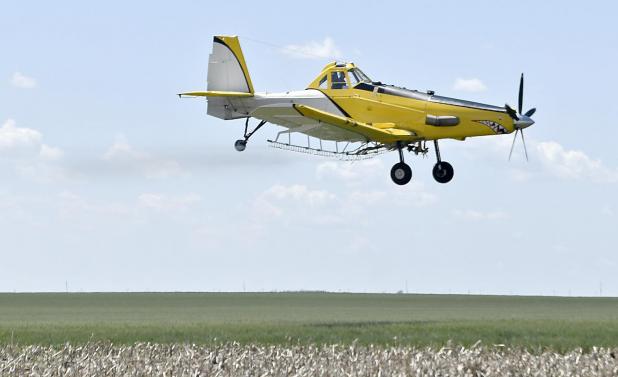
An aerial applicator is shown spraying a wheat field in northwest Chase County early last week to control rust. The window for treating for rust has passed as the crop nears maturity for harvest. (Johnson Publications photo)
Wheat diseases spotty, not as bad as last year
Extension Educator and wheat specialist Strahinja Stepanovic of Grant said disease conditions in this year’s wheat crop do not appear as bad as last year.
He said this week the two primary diseases affecting this year’s wheat crop is stripe rust and wheat streak mosaic.
Stepanovic said south central Nebraska has been hit hard with the stripe rust. Fortunately, he said it’s not as bad in the Perkins-Chase-Dundy County areas.
The window to spray fungicide on the wheat has essentially passed, he said, as the wheat matures toward harvest.
He said it was a tough decision for farmers whether or not to spray the crop.
Stepanovic said the decision to spray last year resulted in about a 30-bushel yield increase compared to not spraying.
That may not be the case this year. Plus, with the price of wheat being soft—in the $3.10 to $3.30 range—farmers had to weigh whether it would pay off in increased production to offset fungicide and aerial application costs.
Stepanovic said they did not spray their test plots this year at the Henry J. Stumpf International Wheat Center just outside of Grant.
Wheat streak mosaic
He said some fields he’s seen are showing the stress from wheat streak mosaic.
Because the disease is a virus, there are no treatment options available after a field has been infected.
The virus is carried by the wheat curl mite and is light enough to be carried from field to field simply by the wind, he said.
The solution to controlling the disease is to destroy volunteer wheat in fields.
The mite moves from the mature crop over to any volunteer wheat that comes up after harvest. From there, it moves to the new crop in the fall.
The virus affects the plant’s tissue and leaf growth and can significantly reduce yields.
Stepanovic said fields that get hailed near harvest provide a perfect breeding ground for the virus when volunteer wheat emerges.
He added there are some varieties of wheat that are resistant to mosaic, providing another way to protect against mosaic damage.
The key is controlling volunteer wheat growth after harvest, he noted.
